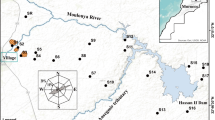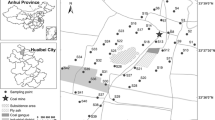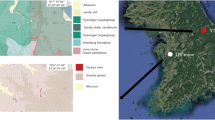Abstract
Mining and smelting activities are potential sources of heavy metal contamination, which pose a threat to human health and ecological systems. This study investigated single and sequential extractions of Zn, Pb, and Cd in Brazilian soils affected by mining and smelting activities. Soils from a Zn mining area (soils A, B, C, D, E, and the control soil) and a tailing from a smelting area were collected in Minas Gerais state, Brazil. The samples were subjected to single (using Mehlich I solution) and sequential extractions. The risk assessment code (RAC), the redistribution index (U ts ), and the reduced partition index (I R ) have been applied to the sequential extraction data. Zinc and Cd, in soil samples from the mining area, were found mainly associated with carbonate forms. This same pattern did not occur for Pb. Moreover, the Fe-Mn oxides and residual fractions had important contributions for Zn and Pb in those soils. For the tailing, more than 70 % of Zn and Cd were released in the exchangeable fraction, showing a much higher mobility and availability of these metals at this site, which was also supported by results of RAC and I R . These differences in terms of mobility might be due to different chemical forms of the metals in the two sites, which are attributable to natural occurrence as well as ore processing.




Similar content being viewed by others
References
Ahnstrom ZS, Parker DR (1999) Development and assessment of a sequential extraction procedure for the fractionation of soil cadmium. Soil Sci Soc Am J 63:1650–1658
Alloway BJ (1990) The origin of heavy metals in soils. In: Alloway BJ (ed) Heavy metals in soils. Wiley, New York, pp 29–39
Brazilian Agricultural Research Corporation (EMBRAPA) (2009) Manual of chemical analyses of soils, plants, and fertilizers. Embrapa Comunication for technology transfer, Brasília, 627pp (in Portuguese)
Fernandes HM (1997) Heavy metal distribution in sediments and ecological risk assessment: the role of diagenetic processes in reducing metal toxicity in bottom sediments. Environ Pollut 97:317–325
Ferreira DF (2009) Sisvar: Variance analysis system. Available URL: www.dex.ufla.br/∼danielff/softwares.htm. Accessed 14 April 2014 (in Portuguese)
Filgueiras AV, Lavilla I, Bendicho C (2002) Chemical sequential extraction for metal partitioning in environmental solid samples. J Environ Monit 4:823–857
Garin MAP, Cappellen V, Charlet L (2003) Aqueous cadmium uptake by calcite: a stirred flow-through reactor study. Geochim Cosmochim Acta 67:2763–2774
Han FX, Banin A (1999) Long-term transformations and redistribution of potentially toxic heavy metals in arid-zone soils. II: under the field capacity regime. Water Air Soil Pollut 114:221–250
Han FX, Banin A, Kingery WL, Triplett GB, Zhou LX, Zheng SJ, Ding WX (2003) New approach to studies of heavy metal redistribution in soil. Adv Environ Res 8:113–120
He ZL, Yang XE, Stoffella PL (2005) Trace elements in agroecosystems and impacts on the environment. J Trace Elem Med Biol 19:125–140
Hejabi AT, Basavarajappa HT (2013) Heavy metals partitioning in sediments of the Kabini River in South India. Environ Monit Assess 185:1273–1283
Hitzman MW, Reynolds NA, Sangster DF, Allen CR, Carman CE (2003) Classifications, genesis, and exploration guides for nonsulfides zinc deposit. Econ Geol 98:685–714
Jackson ML (1979) Soil chemical analysis—advanced course. Prentice-Hall, Madison, 895 p
Jain CK (2004) Metal fractionation study on bed sediments of river Yamuna, India. Water Res 38:569–578
Jain CK, Gupta H, Chakrapani GJ (2008) Enrichment and fractionation of heavy metals in bed sediments of River Narmada, India. Environ Monit Assess 141:35–47
Jalali M, Khanboluki G (2008) Redistribution of zinc, cadmium, and lead among soil fractions in a sandy calcareous soil due to application of poultry litter. Environ Monit Assess 136:327–335
Júnior MB, Mello JWV, Schaffer CEGR, Dussin TM, Júnior JA (2008) Distribution and forms of zinc in the soils from the Vazante municipality - MG. Rev Bras Cienc Solo 32:2183–2194 (in Portuguese)
Korfali SI, Jurdi MS (2011) Speciation of metals in bed sediments and water of Qaraaoun Reservoir, Lebanon. Environ Monit Assess 178:563–579
Li X, Thornton L (2001) Chemical partitioning of trace and major elements in soils contaminated by mining and smelting activities. Appl Geochem 16:1693–1706
Maiz I, Arambarri I, Garcia R, Millán E (2000) Evaluation of heavy metal availability in polluted soils by two sequential extraction procedures using factor analysis. Environ Pollut 110:3–9
Miretzky P, Avendano MR, Munoz C, Chaves AG (2011) Use of partition and redistribution indexes for heavy metal soil distribution after contamination with a multi-element solution. J Soils Sediments 11:619–627
Ministério de Minas e Energia – MME (2010) Technical report 25, zinc ore profile. Available URL: http://www.mme.gov.br/sgm/galerias/arquivos/plano_duo_decenal/a_mineracao_brasileira/P16_RT25_Perfil_do_Minxrio_de_Zinco.pdf. Accessed 10 March 2014 (in Portuguese)
Monteiro LVS, Bettencourt JS, Juliani C, Oliveira TF (2006) Geology, petrography, and mineral chemistry of the Vazante non-sulfide and Ambrósia and sulfide-rich carbonate-hosted Zn-(Pb) deposits, Minas Gerais, Brazil. Ore Geol Rev 28:201–234
Monteiro LVS, Bettencourt JS, Juliani C, Oliveira TF (2007) Non-sulfide and sulfide-rich mineralizations in the Vazante, Ambrósia and Fagundes deposits, Minas Gerais, Brazil: mass balance and stable isotope characteristics of the hydrothermal alterations. Gondwana Res 11:362–381
Pagnanelli F, Moscardini E, Giuliano V, Toro L (2004) Sequential extraction of heavy metals in river sediments of an abandoned pyrite mining area: pollution detection and affinity series. Environ Pollut 132:189–201
Perin G, Fabris R, Manente S, Wagner AR, Hamacher C, Scotto S (1997) A five-year study on the heavy metal pollution of Guanabara Bay sediments (Rio de Janeiro, Brazil) and evaluation of the metal bioavailability by means of geochemical speciation. Water Res 31:3017–3028
Pichering WF (1983) Extraction of copper, lead, zinc or cadmium ions sorbed on calcium carbonate. Water Air Soil Pollut 20:299–309
Ribeiro Filho MR, Curi N, Siqueira JO, Motta PEF (1999) Heavy metals in soils from the zinc processing industry. Rev Bras Cienc Solo 23:453–464 (in Portuguese)
Rigobello AE, Branquinho JA, Dantas MGS, Oliveira TF, Nieves Filho W (1998) Zinc ore of Vazante, Minas Gerais. In: National Department of Mineral Production—NDMP. Main ore deposits of Brazil, v.2, 670p (in Portuguese)
Rodríguez L, Ruiz E, Azcárate A, Rincón J (2009) Heavy metal distribution and chemical speciation in tailings and soils around a Pb-Zn mine in Spain. J Environ Manag 90:1106–1116
Silva IS, Abate G, Lichtig J, Masini JC (2002) Heavy metal distribution in recent sediments of the Tietê-Pinheiros river system in São Paulo state, Brazil. Appl Geochem 17:105–116
Singh KP, Mohan D, Singh VK, Malik A (2005) Studies on distribution and fractionation of heavy metals in Gomti river sediments—a tributary of the Ganges, India. J Hydrol 312:14–27
Soares CRFS, Accioly AMDA, Marques TCLLSEM, Siqueira JO, Moreira FMS (2001) Acúmulo e distribuição de metais pesados nas raízes, caule e folhas de mudas de árvores em solo contaminado por rejeitos de indústria de zinco. Rev Bras Fisiol Veg 13:302–315 (in Portuguese)
Sparks DL (2003) Environmental soil chemistry, 2nd edn. New York, Academic Press, 352p
Tessier A, Campbell P, Bisson M (1979) Sequential extraction procedure for the speciation of particulate trace metals. Anal Chem 51:844–851
Ullrich SM, Ramsey MH, Rybicka EH (1999) Total and exchangeable concentrations of heavy metals in soils near Bytom, an area of Pb/Zn mining and smelting in Upper Silesia, Poland. Appl Geochem 14:187–196
United States Environmental Protection Agency (USEPA) (1998) Method 3051A: microwave assisted acid digestion of sediments, sludges, soils and oils, in: SW-846: Test Methods for Evaluating Solid Waste, Physical/Chemical Methods, Environmental Protection Agency, Washington, DC, pp 1–20
Acknowledgments
First at all, we would like to thank Federal University of Lavras and University of Delaware, where this research has been performed. The authors thank Fapemig, Capes, and CNPq for financial support. Also, we would like to acknowledge CNPq for providing the scholarship to the first author in order to conduct part of this research at the University of Delaware, DE, USA (project 201703/2012-2).
Conflict of interest
The authors confirm that this article has no conflicts of interest.
Author information
Authors and Affiliations
Corresponding author
Additional information
Responsible editor: Zhihong Xu
Rights and permissions
About this article
Cite this article
Lopes, G., Costa, E.T.S., Penido, E.S. et al. Binding intensity and metal partitioning in soils affected by mining and smelting activities in Minas Gerais, Brazil. Environ Sci Pollut Res 22, 13442–13452 (2015). https://doi.org/10.1007/s11356-015-4613-5
Received:
Accepted:
Published:
Issue Date:
DOI: https://doi.org/10.1007/s11356-015-4613-5




